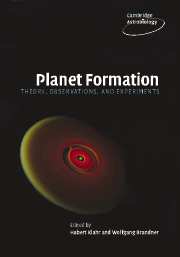Book contents
- Frontmatter
- Contents
- Preface
- Acknowledgments
- 1 Historical notes on planet formation
- 2 The Formation and Evolution of Planetary Systems: placing our Solar System in context
- 3 Destruction of protoplanetary disks by photoevaporation
- 4 Turbulence in protoplanetary accretion disks: driving mechanisms and role in planet formation
- 5 The origin of solids in the early Solar System
- 6 Experiments on planetesimal formation
- 7 Dust coagulation in protoplanetary disks
- 8 The accretion of giant planet cores
- 9 Planetary transits: a first direct vision of extrasolar planets
- 10 The core accretion–gas capture model for gas-giant planet formation
- 11 Properties of exoplanets: a Doppler study of 1330 stars
- 12 Giant-planet formation: theories meet observations
- 13 From hot Jupiters to hot Neptunes … and below
- 14 Disk–planet interaction and migration
- 15 The brown dwarf–planet relation
- 16 Exoplanet detection techniques – from astronomy to astrobiology
- 17 Overview and prospective in theory and observation of planet formation
- References
- Index
11 - Properties of exoplanets: a Doppler study of 1330 stars
Published online by Cambridge University Press: 14 September 2009
- Frontmatter
- Contents
- Preface
- Acknowledgments
- 1 Historical notes on planet formation
- 2 The Formation and Evolution of Planetary Systems: placing our Solar System in context
- 3 Destruction of protoplanetary disks by photoevaporation
- 4 Turbulence in protoplanetary accretion disks: driving mechanisms and role in planet formation
- 5 The origin of solids in the early Solar System
- 6 Experiments on planetesimal formation
- 7 Dust coagulation in protoplanetary disks
- 8 The accretion of giant planet cores
- 9 Planetary transits: a first direct vision of extrasolar planets
- 10 The core accretion–gas capture model for gas-giant planet formation
- 11 Properties of exoplanets: a Doppler study of 1330 stars
- 12 Giant-planet formation: theories meet observations
- 13 From hot Jupiters to hot Neptunes … and below
- 14 Disk–planet interaction and migration
- 15 The brown dwarf–planet relation
- 16 Exoplanet detection techniques – from astronomy to astrobiology
- 17 Overview and prospective in theory and observation of planet formation
- References
- Index
Summary
Overview of exoplanet properties and theory
In the past ten years, 170 exoplanets have been discovered orbiting 130 normal stars by using the Doppler technique to monitor the gravitational wobble induced by a planet, as summarized by Marcy et al. (2004) and Mayor et al. (2004). Multipleplanet systems have been detected around 17 of the 130 planet-bearing stars, found by superimposed multiple Doppler periodicities (Mayor et al., 2004; Vogt et al., 2005). Another five exoplanets have been found photometrically by the dimming of the star as the planet transits across the visible hemisphere of the star (Bouchy et al., 2005; Torres et al., 2005).
The Doppler surveys for planets have revealed several properties:
Planet mass distribution: dN/dM α M−1.5 (Fig. 11.1).
Planet occurrence increases with semimajor axis (Fig. 11.2).
Hot Jupiters (a < 0.1 AU) exist around 0.8% of FGK stars.
Eccentric orbits are common (Fig. 11.3).
Planet occurrence rises rapidly with stellar metallicity (Fig. 11.4).
Multiple planets are common, often in resonant orbits.
The transiting planets permit measurement of planet radius and mass, demonstrating that they are “gas giants”, as expected (Henry et al., 2000; Charbonneau et al., 2000). The properties of the 170 known exoplanets motivate theories of their formation and their dynamical interactions with both the protoplanetary disk and other planets (Bryden et al., 2000; Laughlin and Chambers, 2001; Rivera and Lissauer, 2001; Chiang and Murray, 2002; Lee and Peale, 2002; Ford et al., 2003; Ida and Lin, 2004).
- Type
- Chapter
- Information
- Planet FormationTheory, Observations, and Experiments, pp. 179 - 191Publisher: Cambridge University PressPrint publication year: 2006
- 24
- Cited by

